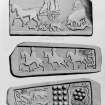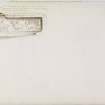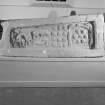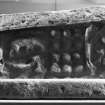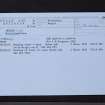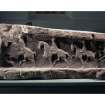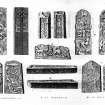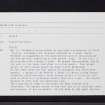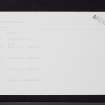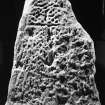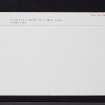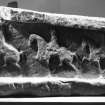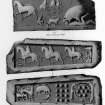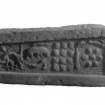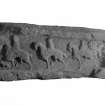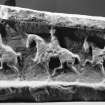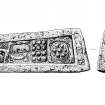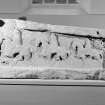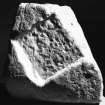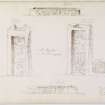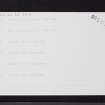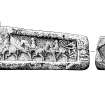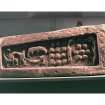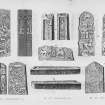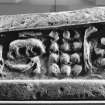Pricing Change
New pricing for orders of material from this site will come into place shortly. Charges for supply of digital images, digitisation on demand, prints and licensing will be altered.
Upcoming Maintenance
Please be advised that this website will undergo scheduled maintenance on the following dates:
Thursday, 30 January: 11:00 AM - 3:00 PM
During these times, some functionality such as image purchasing may be temporarily unavailable. We apologise for any inconvenience this may cause.
Meigle
Gravestone (Pictish)
Site Name Meigle
Classification Gravestone (Pictish)
Alternative Name(s) Meigle Stones; Meigle No. 11
Canmore ID 30840
Site Number NO24SE 25.11
NGR NO 2872 4459
Datum OSGB36 - NGR
Permalink http://canmore.org.uk/site/30840
- Council Perth And Kinross
- Parish Meigle
- Former Region Tayside
- Former District Perth And Kinross
- Former County Perthshire
Meigle 11, Perthshire, recumbent gravestone
Measurements: L 1.73m, H 0.69m to 0.50m, W 0.0.30m (top) to 0.50m (base)
Stone type: sandstone
Place of discovery: NO 2872 4459
Present location: Meigle Museum.
Evidence for discovery: drawn by Thomas Pennant in 1772, at which time it was standing upright in the churchyard with the recessed end uppermost. It was also drawn by James Skene in the early 1830s, first while it was upright (p 24) and then after it had been removed from the ground and laid flat (p 23v).
Present condition:
Description
The largest of the recumbent monuments at Meigle, this slab is carved in relief on three or possibly four sides, but the narrow top, face A, appears to have been plain. Cut into face A at the higher end is a bar socket, 0.10m deep, to take an upright or a relic.
Face B has a wide flat-band border with traces of carved decoration, which surrounds a sunken panel containing four groups of ornament. On the left at the foot of the monument are two busily entwined quadrupeds, to the right of which are a small creature over a bear, both facing right, and beneath them a curved object. Then a panel of twelve spiral bosses, and at the head end a roundel enclosing seven interlinked spiral bosses, which is guarded by two elongated beasts with the body of a human in their jaws.
Face D has a wide, formerly ornamented, border round a sunken panel. This contains three armed horsemen in line riding towards the head of the monument, with a small hound accompanying the foremost rider. Behind them is a beast-headed human figure with a pair of entwined serpents held in one hand and its jaws.
Face E at the head of the slab is carved trace of an interlace pattern, while face F at the foot is carved with a sunken lozenge-shape.
Date: tenth or eleventh century.
References: Skene 1832, 24; RCAHMS 1994, 100, A.
Desk-based information compiled by A Ritchie 2018.
Publication Account (1964)
No. 11 Recumbent grave-stone: on one side a procession of three 'Pictish' horsemen, the foremost attended by a small hound. Movement is suggested by the diminishing size of the cavalcade and the spritely modelling of the horses' legs. In the rear, a dancing man with a beast's head. He grasps two serpents, one by the neck in his hand, the other is in his mouth. The raised margin of this sunken panel has been richly decorated. On the other side are four panels of ornament; two interlaced beasts; a group of two beasts; a panel of twelve raised bosses linked by interlace work; seven bosses within a circle on each side of which is a grotesque beast; they bite a man. The raised margins of this side are decorated also.
The large end or head of the stone has been covered with interlace. The square recess in the rear end is of uncertain date and purpose. It may be modern. At the head of the upper surface is part of a socket for a small cross.
S Cruden 1964.
Note (1990)
NO24SE 25.11 2872 4459.
This massive grave-marker (1.76m in length, 0.69m in maximum height and 0.5m in thickness at the base) has a socket for an upright member at the head of the upper surface and decoration in high relief on both sides, set within heavy borders. On the upper end-face there are worn traces of interlace ornament, while on the lower end-face there is a lozenge-shaped hollow (some 255mm by at least 255mm and 50mm deep), which may represent a re-use of the slab. On the right side there are four ornamental motifs set in a single panel, within a border that retains traces of an interlaced panel: the first has delicately intertwined beasts; the second, three beasts, now very worn; the third, a rectangle of spiral ornament rising into twelve bosses in four rows of three; and the last, a central roundel of spirals containing seven bosses, with beasts on either side and a man with his head in the jaws of one and his feet in the mouth of the other. The tails of the beasts form interlace, filling the spandrels below the roundel. On the left side a panel containing three horsemen riding one behind the other, the leading rider being attended by a hound; at the other end of the panel there is a man grasping two serpents; one bites his ankle, the other has his head in his mouth.
Information from RCAHMS (JNGR) 1990.

































